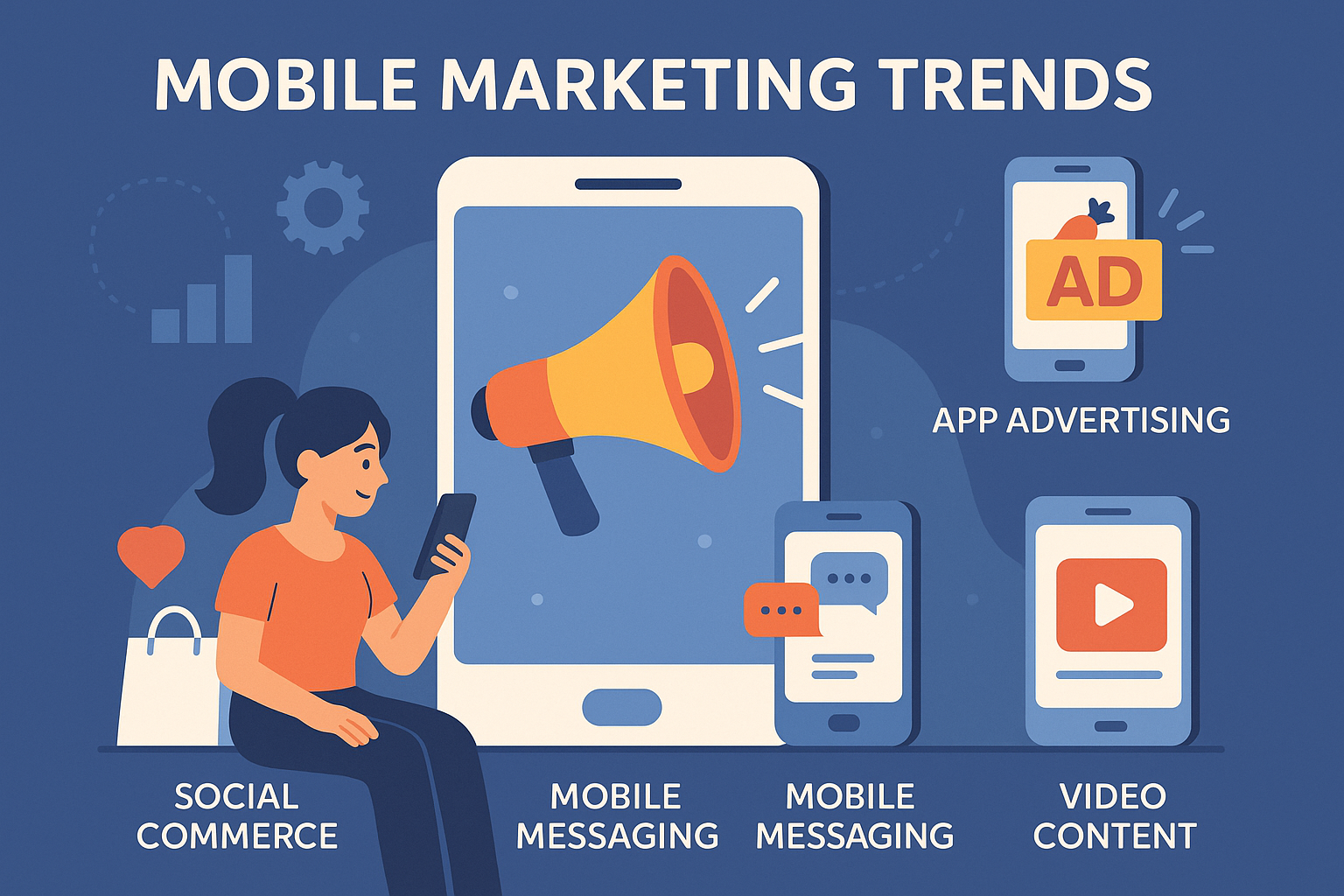As we head into 2025, mobile marketing is evolving faster than ever, and staying ahead of these trends is no longer optional—it’s essential for success. With smartphone penetration reaching unprecedented levels and consumer behaviors shifting dramatically, businesses must adapt to remain relevant. From the rise of hyper-personalization to the ubiquity of AI-driven insights, the landscape is teeming with opportunities to connect with audiences like never before. Savvy marketers are harnessing the power of immersive technologies, such as AR and VR, to create engaging experiences that resonate deeply with users. Moreover, the integration of social commerce is transforming how brands interact with potential customers in real-time. In this article, we’ll explore the top mobile marketing trends you can’t afford to ignore in 2025, equipping you with the insights needed to thrive in an increasingly digital marketplace. Don’t get left behind—embrace the future of marketing today!
Personalization in Mobile Marketing
In 2025, the emphasis on personalization in mobile marketing is reaching new heights as consumers increasingly expect tailored experiences that cater to their individual preferences and behaviors. Hyper-personalization, driven by advanced data analytics and machine learning, allows marketers to deliver highly relevant content, offers, and recommendations that resonate on a personal level. This approach goes beyond basic demographic targeting, utilizing real-time data to understand and predict consumer needs, making interactions more meaningful and engaging.
One of the key components of effective personalization is the use of sophisticated algorithms that analyze user behavior across various touchpoints. By tracking how users interact with mobile apps, websites, and social media platforms, marketers can gain valuable insights into their interests, preferences, and purchasing habits. This data enables the creation of dynamic content that adapts to each user’s journey, providing personalized product recommendations, tailored messaging, and customized offers that can significantly enhance the customer experience and drive loyalty.
Moreover, personalization in mobile marketing extends to communication channels, with brands leveraging push notifications, in-app messaging, and SMS to deliver timely and relevant updates. These messages can be personalized based on user behavior, location, and preferences, ensuring that they capture attention and drive action. For instance, a user who frequently browses fashion items might receive a push notification about a flash sale on their favorite brands, while another user interested in technology could get updates on the latest gadgets and accessories. By delivering the right message at the right time, businesses can foster deeper connections with their audience and increase engagement and conversions.
The Importance of Mobile-First Design
As mobile devices continue to dominate how consumers access information and interact with brands, the importance of mobile-first design has never been more critical. In 2025, businesses that prioritize mobile-first design will be better equipped to meet the needs of their audience and provide a seamless user experience across all devices. This approach involves designing websites, apps, and digital content with mobile users in mind from the outset, ensuring that the user interface (UI) and user experience (UX) are optimized for smaller screens and touch interactions.
Mobile-first design is not just about making content look good on mobile devices; it’s about creating a user experience that is intuitive, efficient, and enjoyable. This means considering factors such as load times, navigation, readability, and touch-friendly elements. For instance, mobile-first websites should have fast loading times to prevent users from bouncing, simple navigation menus that are easy to use on a small screen, and content that is easy to read without excessive scrolling or zooming. By focusing on these elements, businesses can ensure that their mobile users have a positive experience, which can lead to higher engagement and conversions.
In addition to improving the user experience, mobile-first design also has significant implications for search engine optimization (SEO). Search engines like Google prioritize mobile-friendly websites in their rankings, meaning that businesses with mobile-optimized sites are more likely to appear at the top of search results. This can drive more organic traffic and increase visibility, making it easier for potential customers to find and engage with the brand. As mobile usage continues to grow, businesses that adopt a mobile-first approach will be better positioned to succeed in the competitive digital landscape of 2025.
Voice Search Optimization for Mobile Devices
As voice-activated technology becomes more sophisticated and widespread, voice search optimization is emerging as a crucial element of mobile marketing in 2025. With the increasing popularity of voice assistants like Siri, Google Assistant, and Alexa, more consumers are using voice search to find information, make purchases, and interact with brands. This shift in behavior presents a unique opportunity for businesses to optimize their content and strategies for voice search, ensuring that they remain visible and relevant in a voice-first world.
Voice search optimization involves understanding how users phrase their queries when speaking versus typing. Voice searches tend to be more conversational and longer, often in the form of questions. For example, a user might type “best pizza near me” but ask, “Where can I find the best pizza nearby?” To optimize for voice search, businesses need to focus on natural language processing and incorporate long-tail keywords and question phrases into their content. This approach can help improve search engine rankings and ensure that the brand is discoverable through voice search.
Another important aspect of voice search optimization is the creation of concise and informative content that can be easily read aloud by voice assistants. Featured snippets, also known as “position zero” in search results, play a crucial role in voice search, as they are often the source of answers provided by voice assistants. By structuring content to include clear and concise answers to common questions, businesses can increase their chances of being featured in these snippets and gaining visibility in voice search results. As voice search continues to grow, optimizing for this technology will be essential for reaching and engaging with modern consumers.
The Role of Augmented Reality in Mobile Marketing
Augmented reality (AR) is rapidly transforming the landscape of mobile marketing, offering innovative ways for brands to engage with their audience and create immersive experiences. In 2025, AR is expected to become even more prevalent, driven by advancements in technology and increased consumer adoption. By overlaying digital elements onto the real world, AR allows users to interact with products and services in a more meaningful and engaging way, enhancing the overall customer experience and driving brand loyalty.
One of the most compelling applications of AR in mobile marketing is virtual try-ons for fashion, beauty, and home decor products. Brands can use AR to allow customers to visualize how products will look on them or in their homes before making a purchase. For example, a beauty brand can offer an AR experience where users can try on different makeup products and see how they look in real-time using their smartphone camera. Similarly, a furniture retailer can provide an AR app that lets customers see how a piece of furniture will fit and look in their living space. These interactive experiences can reduce uncertainty and increase confidence in purchasing decisions, leading to higher conversion rates.
AR can also be used to create engaging and interactive advertising campaigns that capture the attention of users and encourage them to interact with the brand. For instance, brands can develop AR games or experiences that users can access through their mobile devices, providing entertainment and value while promoting products and services. Additionally, AR can enhance in-store experiences by offering interactive product information, navigation assistance, and personalized recommendations, creating a seamless and integrated shopping experience. As AR technology continues to evolve, its role in mobile marketing will become increasingly important, offering new opportunities for brands to connect with their audience in innovative ways.
Mobile Video Marketing: Engaging Audiences on the Go
In 2025, mobile video marketing is set to dominate the digital landscape as consumers increasingly turn to video content for entertainment, information, and social interaction. With the rise of short-form video platforms like TikTok, Instagram Reels, and YouTube Shorts, brands have a unique opportunity to engage with their audience through compelling and shareable video content. Mobile video marketing allows businesses to capture the attention of users on the go, providing a dynamic and immersive way to communicate their message and drive engagement.
One of the key advantages of mobile video marketing is its ability to convey complex information quickly and effectively. Videos can showcase products, demonstrate usage, and tell brand stories in a way that is both visually appealing and easy to understand. This is particularly important in a mobile-first world where users have limited time and attention spans. By creating engaging and informative videos, brands can capture the interest of their audience and encourage them to take action, whether it’s making a purchase, visiting a website, or sharing the content with their network.
Another important aspect of mobile video marketing is the use of live streaming to connect with audiences in real-time. Live streaming allows brands to interact with their followers, answer questions, and provide exclusive content, creating a sense of immediacy and authenticity. Platforms like Instagram Live, Facebook Live, and YouTube Live offer easy-to-use tools for live streaming, making it accessible for businesses of all sizes. By incorporating live video into their mobile marketing strategy, brands can build stronger relationships with their audience and create memorable experiences that drive loyalty and engagement.
The Growing Influence of Mobile Wallets and Contactless Payments
As the world becomes increasingly digital, the growing influence of mobile wallets and contactless payments is reshaping the way consumers make transactions and interact with brands. In 2025, the adoption of mobile payment solutions such as Apple Pay, Google Wallet, and Samsung Pay is expected to continue rising, driven by the convenience and security they offer. For businesses, this trend presents an opportunity to streamline the payment process, enhance the customer experience, and drive sales through mobile-friendly payment options.
Mobile wallets and contactless payments offer several advantages for both consumers and businesses. For consumers, these payment methods provide a quick and convenient way to make purchases without the need for physical cash or cards. With just a tap of their smartphone, users can complete transactions securely and efficiently, reducing the time spent at checkout. This convenience is particularly important in a mobile-first world where users expect seamless and frictionless experiences. For businesses, accepting mobile payments can lead to faster transactions, improved customer satisfaction, and increased sales, making it a win-win for both parties.
In addition to enhancing the payment experience, mobile wallets also offer opportunities for personalized marketing and loyalty programs. By integrating mobile wallets with loyalty apps, businesses can provide personalized offers, rewards, and promotions directly to their customers’ smartphones. For example, a retail store can send a push notification with a special discount to customers who have their loyalty card saved in their mobile wallet. This targeted approach can drive repeat business and foster customer loyalty by providing relevant and timely incentives.
Moreover, the rise of mobile wallets and contactless payments is also driving the growth of social commerce, where users can make purchases directly within social media platforms. Platforms like Instagram and Facebook are increasingly integrating shopping features that allow users to browse and buy products without leaving the app. This seamless integration of shopping and social interaction creates new opportunities for brands to reach and convert their audience in the spaces where they spend the most time. As mobile wallets and contactless payments continue to evolve, businesses that embrace these technologies will be better positioned to meet the needs of modern consumers and thrive in the digital marketplace.
Leveraging Location-Based Marketing Strategies
Location-based marketing is emerging as a powerful tool for businesses looking to connect with their audience in a more targeted and relevant way. By leveraging the power of mobile devices’ geolocation capabilities, marketers can deliver personalized content, offers, and experiences based on users’ real-time location. In 2025, the use of location-based marketing strategies is expected to grow, driven by advancements in technology and the increasing demand for personalized and contextually relevant interactions.
One of the key benefits of location-based marketing is the ability to reach users at the right place and time with highly relevant messages. For example, a restaurant can send a push notification with a special lunch offer to users who are nearby during lunchtime, encouraging them to visit and take advantage of the deal. Similarly, a retail store can use geofencing to send personalized promotions to users who enter a specific area, driving foot traffic and increasing sales. By delivering timely and location-specific content, businesses can enhance the customer experience and increase the likelihood of conversion.
Location-based marketing also offers valuable insights into consumer behavior and preferences. By analyzing location data, businesses can gain a deeper understanding of where their customers are, how they move, and what places they frequent. This information can be used to create more effective marketing campaigns, optimize store locations, and improve overall business strategy. For example, a brand may discover that a significant portion of its customers visits a particular shopping mall, prompting them to open a new store in that location or run targeted advertising campaigns in the area.
In addition to driving sales and gaining insights, location-based marketing can also enhance customer loyalty and engagement. By providing personalized and contextually relevant experiences, businesses can build stronger connections with their audience and foster long-term relationships. For instance, a coffee shop can use location-based marketing to reward frequent visitors with exclusive offers or invitations to special events, creating a sense of appreciation and loyalty. As the use of location-based marketing strategies continues to grow, businesses that leverage this approach will be better positioned to connect with their audience in meaningful ways and drive success in the competitive landscape of 2025.
Conclusion: Preparing for the Future of Mobile Marketing
As we look ahead to 2025, the future of mobile marketing is brimming with opportunities and challenges. The rapid evolution of technology, coupled with changing consumer behaviors, demands that businesses stay agile and forward-thinking to remain competitive. From the transformative power of 5G and the increasing importance of personalization to the rise of immersive technologies and the growing influence of mobile wallets, the trends shaping mobile marketing are set to redefine how brands connect with their audience.
To thrive in this dynamic environment, businesses must embrace these trends and integrate them into their marketing strategies. This means investing in advanced technologies, leveraging data-driven insights, and prioritizing the user experience across all touchpoints. By staying ahead of the curve and adapting to emerging trends, businesses can create meaningful and engaging experiences that resonate with their audience and drive long-term success.
Moreover, it is essential for marketers to remain curious and open to experimentation. The landscape of mobile marketing is constantly evolving, and what works today may not be effective tomorrow. By staying informed about the latest developments, testing new approaches, and continuously refining their strategies, businesses can stay relevant and capitalize on new opportunities as they arise.
In conclusion, the future of mobile marketing is bright, with endless possibilities for innovation and growth. By embracing the trends and technologies shaping the industry, businesses can build stronger connections with their audience, enhance the customer experience, and achieve their marketing goals. As we head into 2025, the key to success lies in staying adaptable, leveraging data and technology, and always putting the customer at the center of your marketing efforts. The future is mobile, and the time to prepare for it is now.




